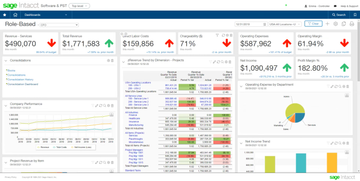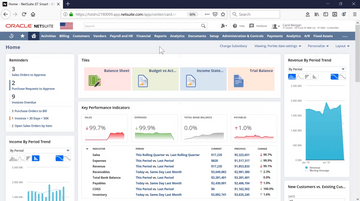NetSuite vs. Sage Intacct Comparison Guide
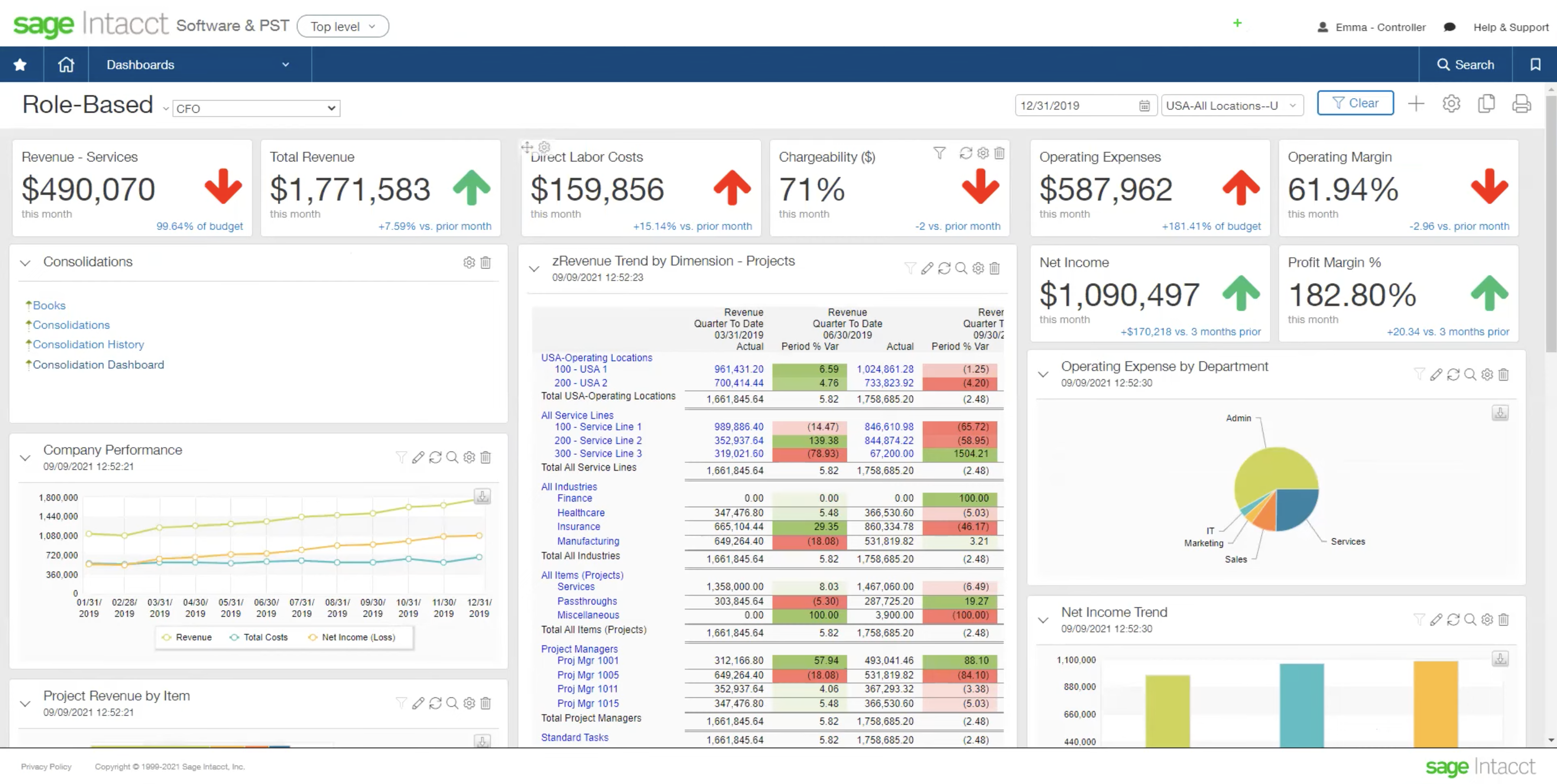
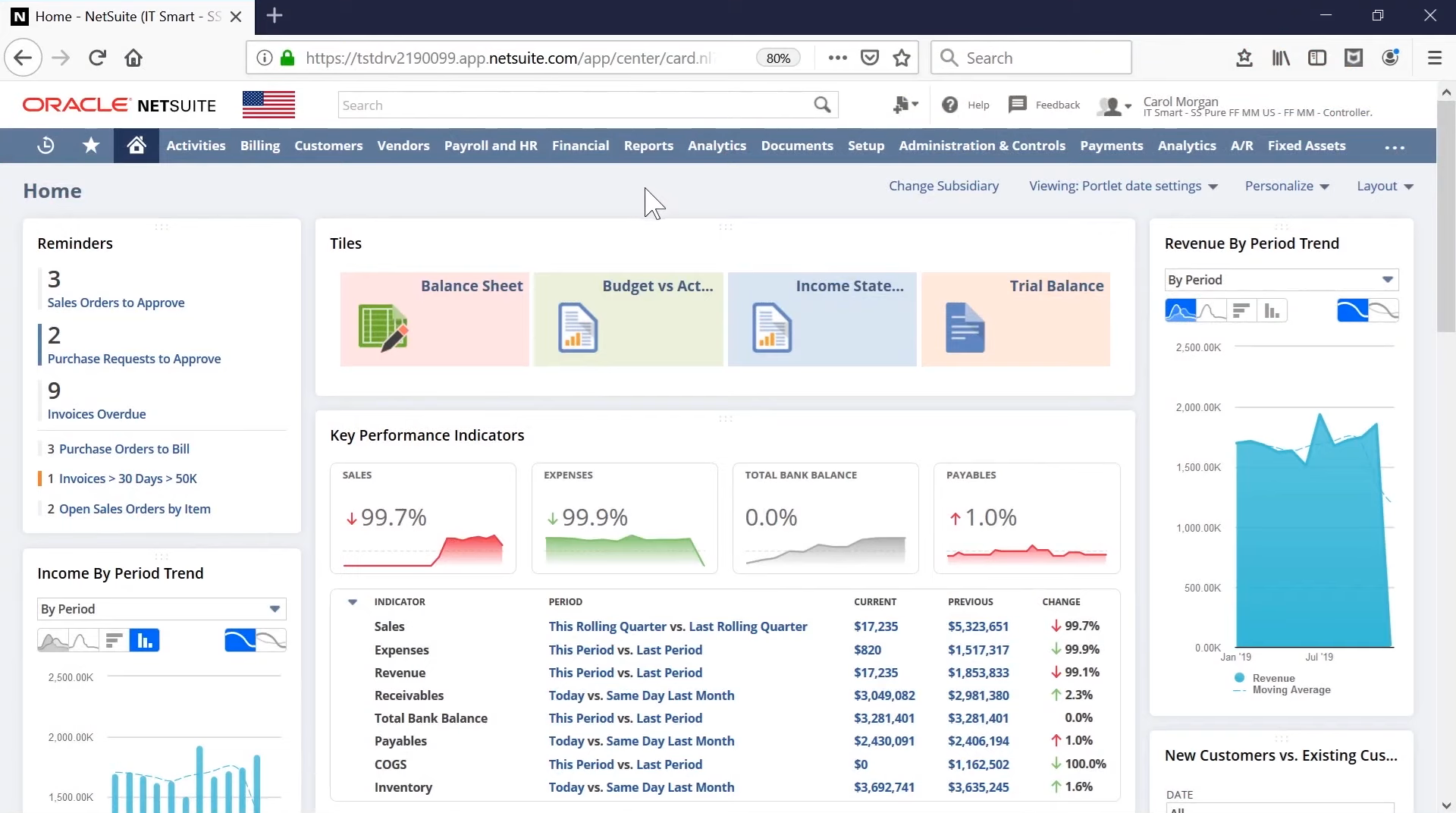
-
Price Range
$ $ $ $ $$ $ $ $ $
- Starting Price $8,580/year
- Client OS Web
-
Price Range
$ $ $ $ $$ $ $ $ $
- Starting Price $1,428/month
- Client OS Web
NetSuite is a cloud-based ERP system that includes a core financial management module with other add-ons like HR and CRM. Sage Intacct is not an ERP but an accounting software and financial management system that offers project accounting and multidimensional reporting. While both systems are widely used, NetSuite offers a more complete business solution, while Sage Intacct is best for companies requiring in-depth financial management.
This post will discuss the differences and similarities between NetSuite and Sage Intacct, including the features, pricing, number of users, and other frequently asked questions.
NetSuite Company Profile
NetSuite ERP is designed for modern companies that require cloud access and mobile-enabled tools. This works great for companies with multiple locations, as they can access the same information as another in real-time, wherever they are located. NetSuite is designed to support growing organizations, as it lets you add or customize features as your company grows.
NetSuite was acquired by Oracle back in 2016. Oracle has continued to improve the product while being backed by a multinational computer technology corporation. Oracle was recently listed as one of our top ERP vendors, which continues to make NetSuite work great for companies with multiple locations and/or supports growing organizations.
Key features of Oracle NetSuite include financial management, fixed assets, billing and invoicing, and inventory management. The solution aims to improve employee productivity via software automation and cross-departmental system integration.
These goals are accomplished through real-time data visibility, which facilitates better business decision-making, reduces technology support costs via outsourced application hosting, and eliminates dedicated server hardware investment costs.
Target Market
NetSuite is used by companies across several industries, including distribution, manufacturing, and professional services. It’s best for mid to large-sized businesses with 50 to over 1,000 employees looking for an all-in-one ERP to support multi-location global operations.
Sage Intacct Company Profile
Intacct was founded in 1999 and was one of the first web-based, cloud accounting products available for the SMB market. The solution was most known for being an in-depth financial management system, as it offered a suite of accounting software that could serve medium and large-sized businesses with consolidated ERP and e-commerce features. It is also considered one of the best multi-entity accounting systems on the market.
Most of Sage Intacct’s applications are financial-based, including accounts payable, accounts receivable, cash management, a general ledger, order management, purchasing, and reporting and dashboards. Intacct also includes support for financial reporting, billing, sales and use tax, inventory management, and project accounting.
Target Market
The Intacct solution is particularly popular with professional services companies because it supports time-based billing, is easy to use for remote professionals, and has strong project accounting features. It’s ideal for small to midsize companies with 15 to 250 employees, or between $5M and $200M annual revenue. In addition to professional services, it’s also used in nonprofit, retail, and healthcare businesses, usually with multiple entities.
Key Features Comparison
Financial Accounting
| Feature | NetSuite | Sage Intacct |
|---|---|---|
| Accounts Payable | Yes | Yes |
| Accounts Receivable | Yes | Yes |
| General Ledger | Yes | Yes |
| Multi-Currency Accounting | Yes | Yes |
| Multi-Entity Accounting | Yes | Yes |
| Fixed Asset Management | Yes | Yes |
| Budgeting and Forecasting | Yes | Yes |
Human Resources
| Feature | NetSuite | Sage Intacct |
|---|---|---|
| Recruiting | Yes | No |
| Applications | Yes | No |
| Onboarding | Yes | No |
| Benefits Administration | Yes | No |
| Multi-Entity Accounting | Yes | No |
| Time and Attendance | Yes | No |
| Payroll | Yes | No |
Supply Chain Management
| Feature | NetSuite | Sage Intacct |
|---|---|---|
| Order Management | Yes | Yes |
| Material Resource Planning | Yes | No |
| Inventory Management | Yes | Yes |
| Purchase Orders | Yes | Yes |
| Warehouse Management | Yes | No |
| Demand Planning | Yes | No |
| Work Orders | Yes | No |
| Shop Floor Control | Yes | No |
NetSuite is primarily an ERP system over an accounting solution. In fact, it is perhaps the most well-known cloud ERP software, meaning it includes a broad range of enterprise functionalities including:
- Financial management
- Supply chain
- Inventory control
- Procurement
- Billing
- Warehouse & fulfillment
- Human capital management
Sage Intacct includes support for core accounting, financial reporting, billing, purchasing, sales and use tax, inventory management, and project accounting.
The Intacct solution is particularly popular with professional services companies based on extensive support of time-based billing, ease of use for remote professionals, and strong project accounting features.
Similarities and Differences
The easiest way for your business to understand which option is right for you is to compare the solutions based on their similarities and differences:
Main Similarities
Perhaps the biggest similarity between the two solutions is that they are both cloud-native solutions. Both systems were built from the ground up as a SaaS solution, so there’s no reliance on legacy architecture or retrofitting old structures. The solutions are billed on a subscription-based pricing model. They both store data off-site and can be accessed from any device or browser wherever you can access the internet, both appealing to remote workplaces.
NetSuite and Intacct are also huge improvements from most small business accounting software, such as QuickBooks Online, Sage 50cloud (Peachtree), or Xero.
Both solutions are also highly customizable. Fast-growing companies will usually try to squeeze as much value as they can out of their software investment. These growing companies likely have accounting needs that are constantly changing or being improved upon, and both Oracle NetSuite and Sage Intacct are up for the challenge.
Key Differences
One major difference between NetSuite and Sage Intacct is their capabilities. NetSuite is more of a modern ERP system with offerings that go well beyond the needs of a normal accounting department. This allows you to easily add on capabilities for CRM, eCommerce, point of sale, inventory, and manufacturing management modules. Meanwhile, Intacct is focused almost exclusively on financial management.
Another major difference between the two systems is their audience scope. NetSuite, powered by Oracle, has a huge base with over 42,000 customers in over 219 countries. The software has 27 supported languages in which it can be interfaced and can handle 190 different currencies. Sage Intacct also targets customers of many sizes. However, it has a customer base of about half of NetSuite (around 12,000). It also only supports English, Spanish, and Canadian French, but is still used globally in several countries across Europe, Africa, and New Zealand.
While NetSuite can operate as a modern accounting system, it can also handle complex business processes with all the available additional functionality. Because of this, NetSuite negates the need for any additional add-ons or applications. Sage Intacct is more strongly focused on being an accounting solution and should not be regarded as a complete suite. To make it one, you’ll require some outside assistance or integrate with other industry-specific Sage products.
NetSuite vs Intacct Pricing Guide
Both solutions are priced vastly differently. Sage Intacct is generally a less expensive option than NetSuite. But what do both solutions cost? The price is set by a complicated combination of your application needs, hosting costs, and any additional support or add-ons needed from your software provider.
What is the Cost of NetSuite?
Pricing for NetSuite varies depending on user count, support expectations, module selections, implementation needs, and a variety of other factors. The following chart provides a breakdown of the estimated maximum of three-year spending ranges reported by software buyers who recently considered NetSuite as a possible purchase option.
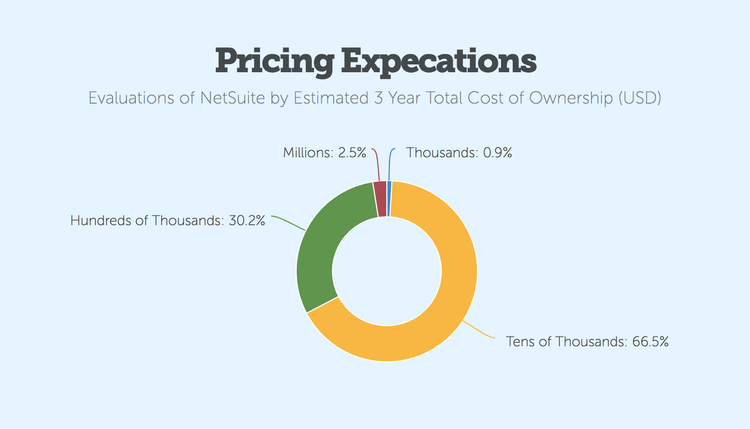
The bare minimum cost of NetSuite is $1,299/month plus $129/user/month for the starter pack. This usually comes with a contract that you will need to renew annually. Additional fees will exist for the implementation, needed integrations, customizations, and data migration (called setup fees). These setup fees will range from 100%-200% of your overall annual subscription cost. For example, if your business expects to spend upwards of $20,000/year on your NetSuite subscription costs, you’ll also have around a $20,000 to $40,000 price tag for your setup fees.
One final factor that will muddy the waters is the cost of the additional services. While NetSuite has a direct sales team, most businesses likely purchase NetSuite from value-added resellers (VARs). These are the companies you pay to implement your software and provide you with direct support.
Learn more about the cost of ERP.
What is the Cost of Sage Intacct?
Pricing depends on a variety of factors. User and functional requirements play the most significant role in affecting base licensing costs. The cost of implementation (configuration and data migration) and training services can also substantially affect overall project pricing.
The following chart displays a breakdown of estimated maximum spending ranges reported by software buyers who recently reviewed the solution as a purchase option.
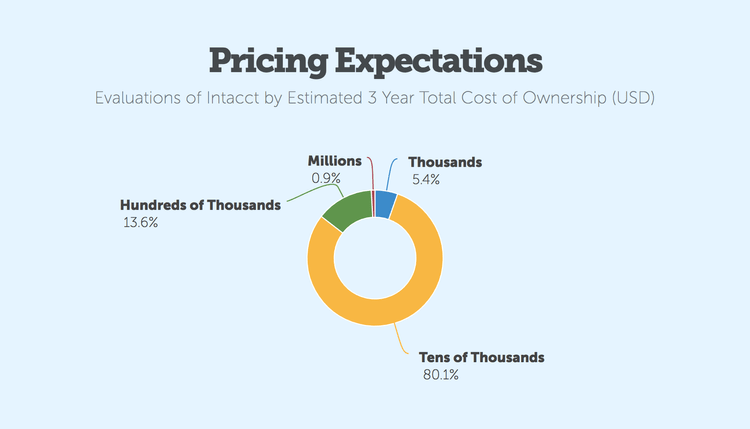
The cost of Sage Intacct starts at $400/month for base applications with a $225/user/month charge for licensing. Sage Intacct requires annual contracts that you renew each year. There are also additional fees for integrations or add-ons, depending on your needs. Generally, a company should expect to spend upwards of $8,000/year at a minimum for a single-user system.
Our Verdict
We like Sage Intacct for its multi-entity financial reporting, effective integrations, and industry-specific services. For example, Intacct offers out-of-the-box functionality, from comprehensive fund accounting to healthcare financial management. This makes it a good option for small businesses in the professional services, nonprofit, and healthcare industries. It’s also one of the best accounting systems for multiple entities on the market.
We like NetSuite for its advanced features, extensive customization, and powerful integrations. NetSuite offers industry-specific software editions to generate leading practice reports and boost out-of-the-box functionality. It integrates with eCommerce platforms, point-of-sale applications, and more. We recommend NetSuite for midsize distributors, manufacturers, and businesses requiring a standardized ERP system.
